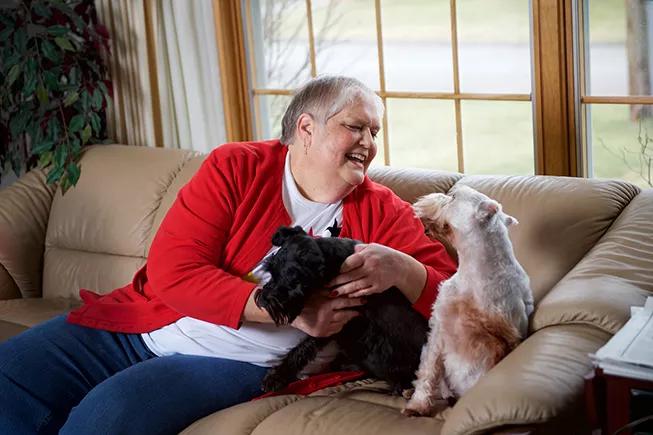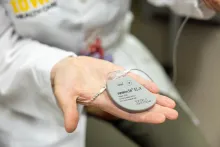New implant offers alternative to blood thinners for reducing stroke risk associated with a-fib

Atrial fibrillation—also known as AF or A-Fib—is the most common heart rhythm disorder. But Linda Sliefert of Muscatine, Iowa, knows that just because A-Fib is common, that doesn’t mean it can be taken lightly.
“I was hospitalized in Muscatine for another reason, but when they discovered my A-Fib, they didn’t want to do any other procedures until that was under control,” Linda says. “So they sent me to Iowa City.”
At University of Iowa Heart and Vascular Center, Linda learned that while A-Fib is a permanent condition, it can be managed. But A-Fib can also lead to serious complications, including stroke.
That’s because in some high-risk patients, the irregular heartbeat of A-Fib can cause blood to pool and clot in the heart. A clot that breaks free and moves through the bloodstream to the brain can cause a stroke.
Many high-risk A-Fib patients take blood-thinning medication to keep pooling blood from clotting. But Linda had a history of brain bleeds. Long-term use of a prescription blood thinner would put her at risk for more bleeding.
Cardiologist Gardar Sigurdsson, MD, clinical associate professor of internal medicine, told Linda about a new alternative to blood-thinning medication: Watchman™, a tiny device that is implanted in the heart to close off a small pouch, called the left atrial appendage, where clots can form.
“He said that with my type of atrial fibrillation, 80 to 90 percent of the blood clots form there,” Linda says. “Watchman™ helps to prevent that.”
Watchman™ does not require surgery. Instead, its umbrella-like shape allows it to be collapsed and moved into the heart through a catheter that’s threaded through the arteries. When Watchman™ reaches the heart, it is expanded and moved into place.
Cardiologist Phillip Horwitz, MD, clinical professor of internal medicine, performed Linda’s Watchman™ procedure in July 2016. A followup exam in September showed that heart tissue around the device had healed, sealing off the area and preventing clots from being released.
“This doesn’t cure the A-Fib,” Linda says. “It’s just a way to manage the clotting.”
But with her stroke risk greatly reduced, she’s been able to focus on lifestyle changes to keep her A-Fib under control.
“I feel so much better,” she says.
New technologies like Watchman™ are not widely available because they require special expertise.
“We’re one of the very first sites in Iowa doing this procedure,” Horwitz says. “And we were involved in clinical trials of these types of devices even before they were available commercially. It’s just one component of our large and advanced Structural Heart Disease Program.”
Patient Stories

